Are you eager to expand your knowledge about vegetables that start with B? Your search ends here! This article presents a compilation of such herbs and vegetables, with fascinating facts and trivia. From widely recognized options like broccoli, Brussels sprouts, and bok choy to a host of lesser-known varieties, there is a plethora of remarkable edible goodness commencing with the letter B. So, without any more delay, let’s embark on an illuminating exploration of these and discover their exceptional contributions to your health and wellness journey.
9 Vegetables That Start With B
1. Broccoli
Broccoli is a cruciferous vegetable, joining the ranks of cabbage, kale, cauliflower, and Brussels sprouts. Its distinct appearance resembles a tree, with a sturdy stalk supporting a cluster of florets.
As an annual plant, broccoli can reach heights of up to 35 inches and span 24 inches in width. Its taproot delves up to 12 inches beneath the soil’s surface. Thick and woody stems support large, dark green leaves. Clusters of small, yellow flowers grace the ends of the stems, giving way to dry capsules containing tiny black seeds.
Broccoli manifests in three primary varieties:
- Calabrese broccoli: This prevalent type showcases a sizable green head and robust stalks. Its name is from Calabria, an Italian province recognized for cultivating this vegetable.
- Sprouting broccoli: Distinguished by its smaller heads and slender stalks, this variation generates abundant side shoots. It is also referred to as broccoli rabe or rapini.
- Purple cauliflower: It sports a purple head similar to cauliflower and has a sweeter, milder taste than regular broccoli.
Description and Appearance
Broccoli’s fresh heads take on a round or oval shape, displaying vibrant shades of green or purple. The surface is textured and covered in numerous tightly packed small buds or florets. These florets come in different sizes, ranging from 0.4 to 2 inches in diameter. Regarding texture, broccoli offers a delightful combination of crispness and tenderness. Cooking it results in a softer texture. Its flavor is mild, with a subtle hint of bitterness.
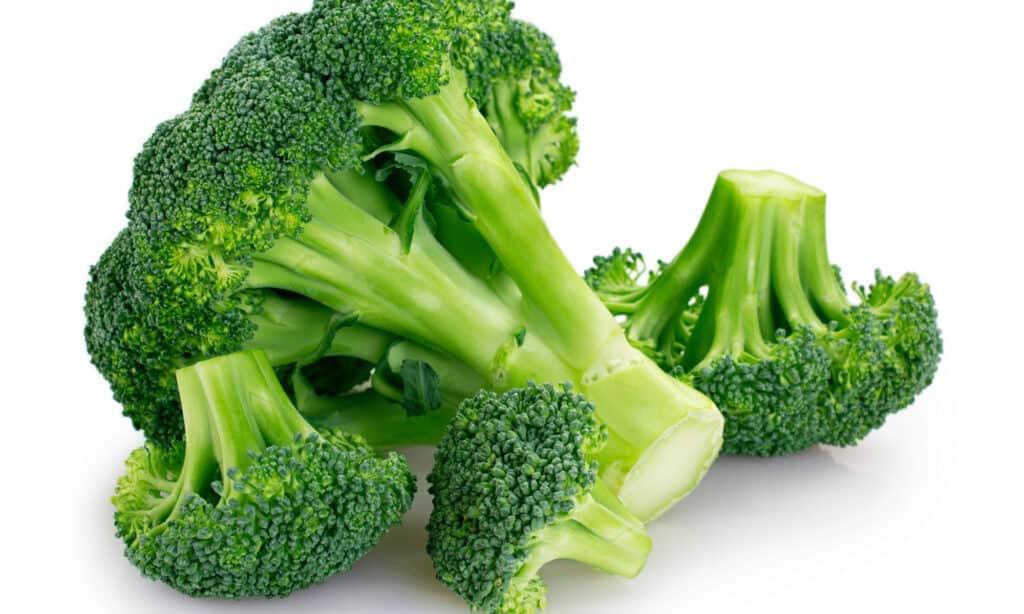
Broccoli offers a delightful combination of crispness and tenderness.
©Valery121283/Shutterstock.com
Nutritional Value per 100 Grams
- Calories: 34
- Protein: 2.8 grams
- Fat: 0.4 grams
- Carbohydrates: 6.6 grams
- Fiber: 2.6 grams
- Vitamin C: 89% of the Daily Value (DV)
- Vitamin K: 102% of the DV
- Folate: 16% of the DV
- Vitamin A: 12% of the DV
- Manganese: 10% of the DV
- Potassium: 9% of the DV
- Iron: 6% of the DV
- Calcium: 5% of the DV
2. Beetroot
Beetroot originated in the Mediterranean region. It was cultivated by ancient Egyptians, Greeks, and Romans for its edible roots and leaves. Immigrants and traders later introduced it to other parts of Europe and America. Today, beetroot is grown in various countries, notably China, Russia, France, Poland, and the United States.
Beetroot thrives in cool climates and moist soil, tolerating frost but not heat or drought. It is typically planted in spring or summer and harvested within 50 to 70 days for baby beets or 90 to 120 days for mature beets. Harvesting methods include pulling out the whole plant or cutting off the root.
Numerous beetroot varieties exist, each distinguished by its shape, size, color, and flavor. Among the most popular ones are:
- Detroit Dark Red: This variety boasts a round shape, a dark red color, and a sweet flavor. It is ideal for canning, pickling, or consuming fresh.
- Chioggia: Also known as candy cane beet or bull’s eye beet, this variety has a flat shape with red-and-white stripes and a mild flavor.
- Golden: With a round shape, yellow-orange color, and sweet flavor, this variety is less likely to cause stains compared to red beets.
- Cylindra: Sometimes referred to as Formanova or butter slicer beet, this variety has a cylindrical shape, dark red color, and a sweet flavor.
- Albina Vereduna: Also known as white beet, this variety features a round shape, white color, and a mild flavor.
Description and Appearance
Its fresh roots are either round or oval, boasting a vibrant red or purple hue. The roots have a smooth surface with growth rings. Their diameter ranges from 0.8 to 4 inches. Beetroot’s firm and juicy texture tenderizes when cooked, retaining its sweet and earthy flavor. This delightful vegetable can elevate the taste of numerous dishes.
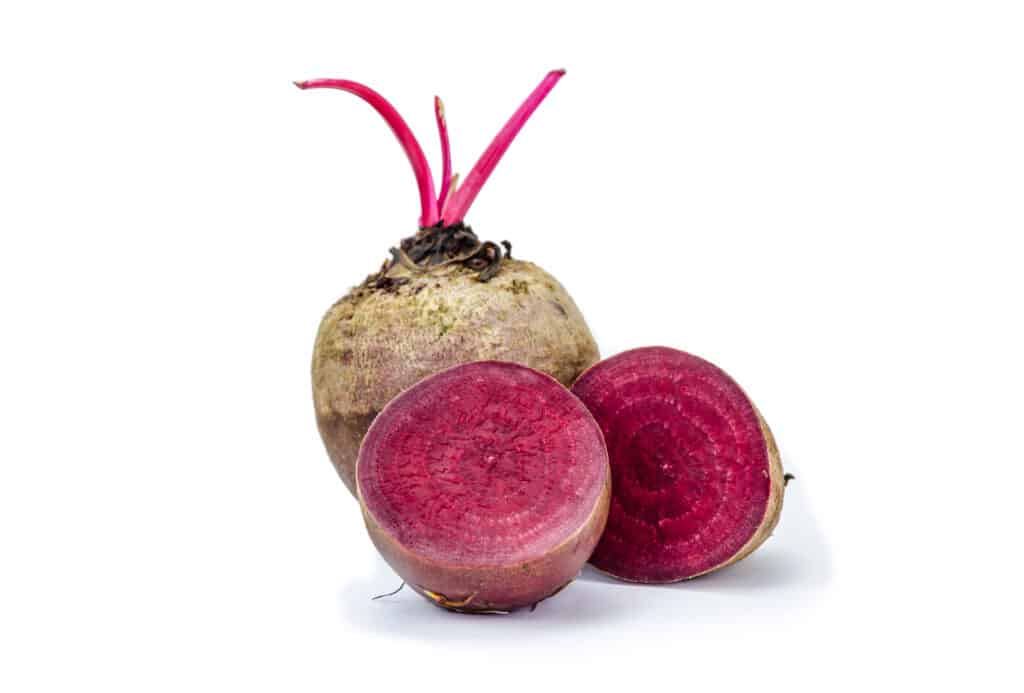
Today, beetroot is grown in various countries, notably China, Russia, France, Poland, and the United States.
©Pingun/Shutterstock.com
Nutritional Value per 100 Grams
- Calories: 43
- Protein: 1.6 grams
- Fat: 0.2 grams
- Carbs: 9.6 grams
- Sugar: 6.8 grams
- Fiber: 2.8 grams
- Vitamin C: 4.9 mg (6% of the Daily Value or DV)
- Folate: 109 mcg (27% of the DV)
- Manganese: 0.329 mg (16% of the DV)
- Potassium: 325 mg (7% of the DV)
- Magnesium: 23 mg (6% of the DV)
- Iron: 0.8 mg (6% of the DV)
3. Basil
Basil is a popular herb that belongs to the genus Ocimum within the family Lamiaceae. This herb boasts diverse cultivars, each imparting its signature essences to numerous global cuisines.
- Cinnamon Basil: Warm undertones reminiscent of cinnamon bark when crushed. Excellent for curries, stews, and tomato sauces.
- Holy basil (Tulsi): Native to India, tulsi has spiritual significance; also offers anti-inflammatory effects and cardiovascular protection. Best consumed raw or lightly blanched.
- Lemon Basil: Leaves emit an intensely fragrant lemony scent when bruised; pairs exceptionally with fish, seafood, and tea. Grows more upright compared to Genovese basil.
- Purple basil: Leafy foliage features vibrant purplish hues; sweeter, less pungent compared to dark green basils; enhances cocktails, balsamic vinegar reductions, and desserts.
- Spicy Globe basil: Slightly smaller than Italian large leaf basil, retains anise-like notes and pepperiness. Complements robust meat, poultry, and vegetable dishes.
Description and Appearance
The basil stems have a square form and exhibit a slight fuzziness. The square shape becomes more prominent as the plants grow bigger and mature. Nevertheless, even in seedlings, you can easily detect it by touching the stem and identifying the firm edges as your fingers glide along its surface.
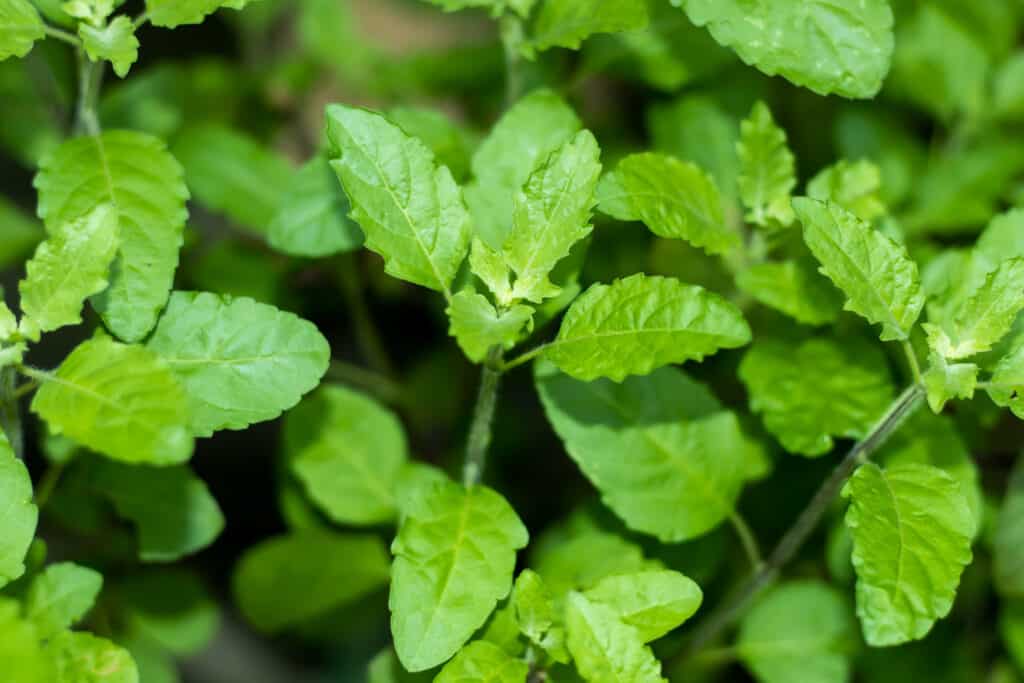
Holy basil gained its name from the cultural belief in India that it has special spiritual powers and can impart great medicinal benefits to those who eat it.
©iStock.com/Abul Hossain Asif
Nutritional Value per 100 Grams
- Calories: 22
- Protein: 3.2 grams
- Fat: 0.0 grams
- Carbs: 2.7 grams
- Fiber: 1.6 grams
4. Borage
Borage, a herbaceous plant from the Boraginaceae family, thrives in the Mediterranean region and has been cherished for ages for its delightful culinary, medicinal, and decorative qualities. Its beautiful blue blossoms beckon bees and other pollinators, earning it the alternate names of starflower, bee bread, and bee plant.
Description and Appearance
Borage can reach 2 feet and spread out 18 inches wide. Its taproot extends deep into the soil, reaching up to 2 feet. The stems, covered in hair and branching out, support the plant’s alternate, oval, and wrinkled leaves, which have a rough texture. The flowers catch the eye with their star-like shape, boasting five petals and prominent black anthers. While commonly blue, they can also display shades of pink or white. The plant produces nutlet fruits housing tiny black seeds.
For optimal growth, borage thrives in sunlit areas with well-drained soil. While it can endure drought and frost, excessive waterlogging proves unfavorable. This versatile plant easily sprouts from either seeds or cuttings and readily self-seeds. Throughout the growing season, borage offers a continuous harvest, yet the prime time for picking the leaves and flowers is during their youthful and tender stage.
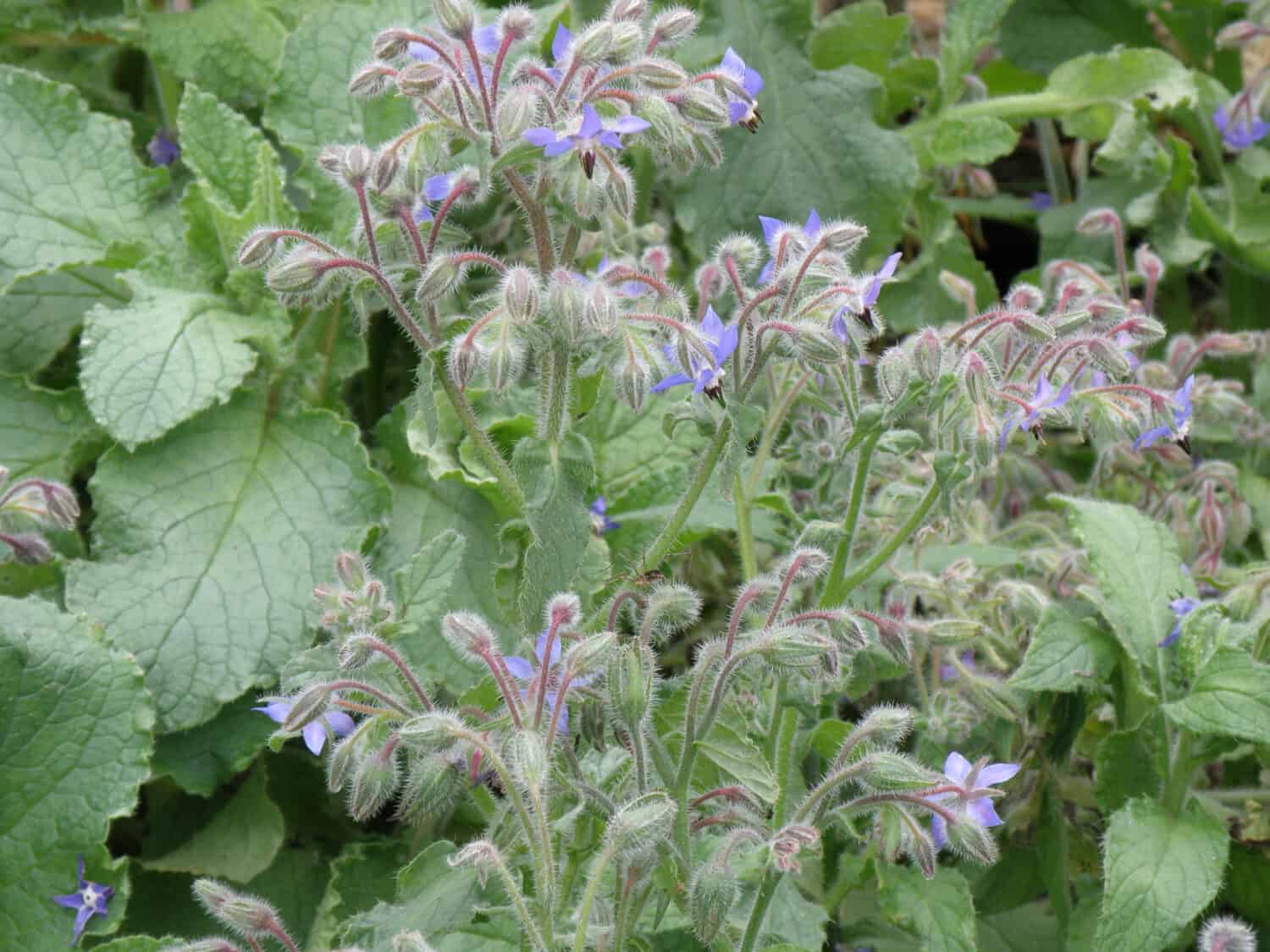
Borage has been cherished for ages for its delightful culinary, medicinal, and decorative qualities.
©Nature’s Charm/Shutterstock.com
Nutritional Value per 100 Grams
- Calories: 21
- Protein: 1.8 g
- Carbohydrates: 3.1 g
- Fiber: 1.1 g
- Sugars: 0.5 g
- Fat: 0.7 g
- Calcium: 93 mg
- Iron: 3 mg
- Magnesium: 52 mg
- Phosphorus: 53 mg
- Potassium: 470 mg
- Sodium: 80 mg
- Zinc: 0.2 mg
- Vitamin C: 35 mg
- Folate: 13 µg
5. Bamboo Shoots
Various bamboo plants belonging to the grass family give rise to bamboo shoots. Bambusa vulgaris and Phyllostachys edulis are among the commonly harvested bamboo species for their edible shoots. These plants naturally thrive in Asia’s tropical and subtropical regions, but they can also be cultivated in other suitable climates and soils worldwide.
Bamboo plants have a tremendous growth rate, reaching up to 98 feet. Nodes segment their hollow stems, decorated with leaves of different shapes and sizes depending on the species. Shoots emerge from the plant’s underground rhizomes or roots, typically during the spring or summer. These shoots can grow an astonishing 12 inches daily, requiring timely harvesting before they become excessively woody and fibrous.
Description and Appearance
Its fresh shoots are cylindrical or conical, sporting a pale yellow or green hue. They boast a smooth surface with longitudinal grooves or ridges. The shoots vary in size, ranging from 2 to 12 inches in length and 0.8 to 4 inches in diameter.
Bamboo shoots have a crisp and juicy texture similar to water chestnut or artichoke heart. Its mild and slightly sweet flavor can elevate the taste of various dishes. Whether enjoyed alone or with meat, seafood, vegetables, noodles, rice, or sauces, it adds a delightful touch to culinary creations.

Bamboo shoots have a crisp and juicy texture similar to water chestnut or artichoke heart.
©Food Impressions/Shutterstock.com
Nutritional Value Per 100 Grams
- Calories: 27
- Protein: 2.6 grams
- Fat: 0.3 grams
- Carbohydrates: 5 grams
- Fiber: 2 grams
- Calcium: 13 mg
- Iron: 0.5 mg
- Magnesium: 3 mg
- Phosphorus: 59 mg
- Potassium: 533 mg
- Sodium: 4 mg
- Zinc: 1.1 mg
- Vitamin C: 4 mg
- Vitamin B6: 0.24 mg
- Folate: 7 mcg
6. Brussels Sprouts
Like other cruciferous veggies such as broccoli, kale, cauliflower, collard greens, and cabbage, Brussels sprouts belong to the Brassica oleracea botanical group. These plants have glucosinolates — a sulfur compound — contributing to their aromatic scent and slightly acrid taste.
Description and Appearance
At a glance, Brussels sprouts resemble tiny heads of cabbage with a dense core surrounded by tightly packed leaves. When raw, they look like little buttons ranging from green to yellow color, depending on the maturation stage and ripeness. Fully grown Brussels sprouts range from pea-sized to walnut-size. Some rare varieties can even exceed golf ball size!
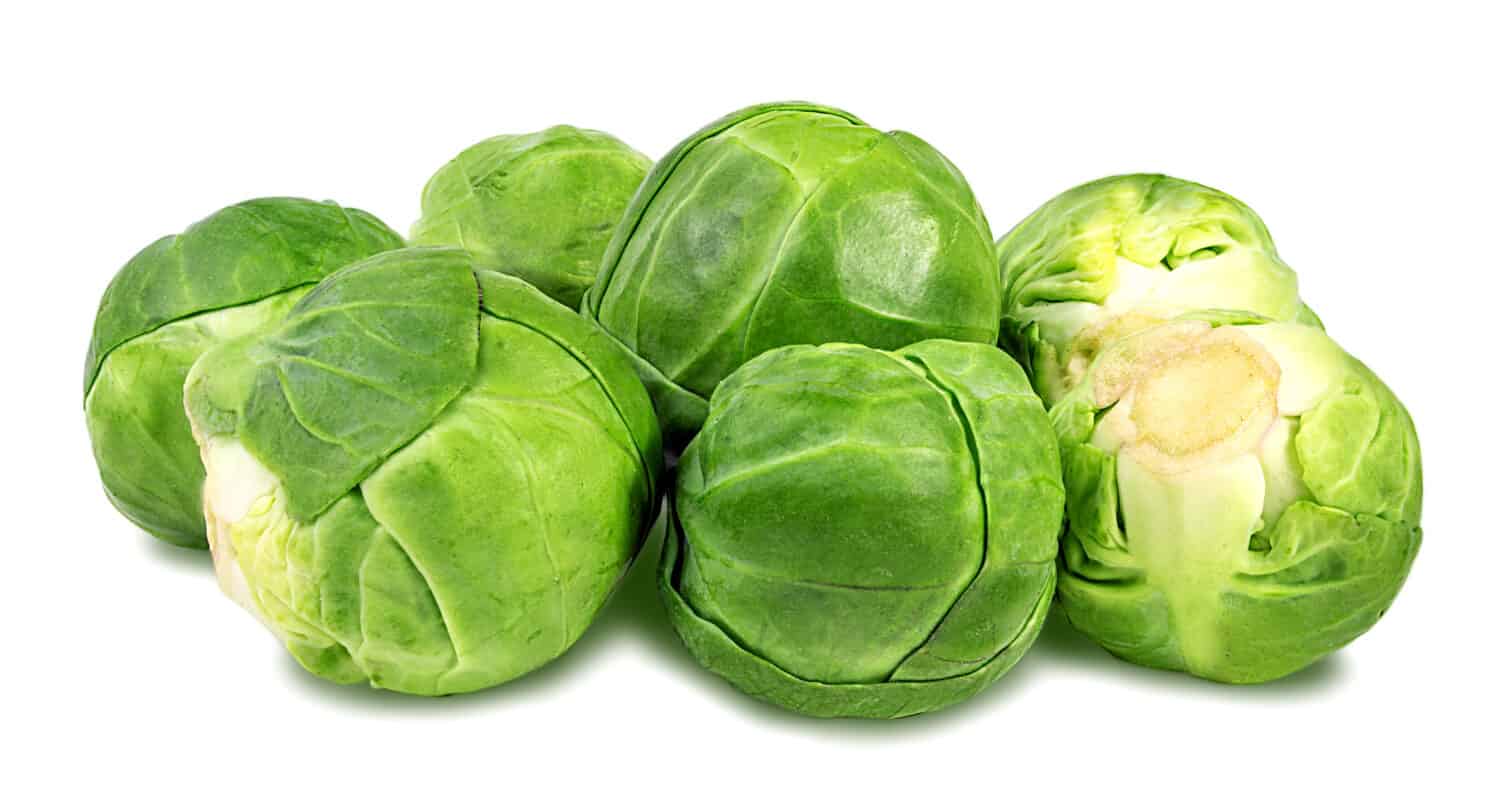
At a glance, Brussels sprouts resemble tiny heads of cabbage with a dense core surrounded by tightly packed leaves.
©Chatham172/Shutterstock.com
Nutritional Value per Cup
- Calories: 56
- Carbohydrates: 8 g
- Protein: 3 g
- Fiber: 3.3 g
- Sugar: 2 g
- Vitamin K: 177 mcg
- Vitamin C: 74.8mg
- Folate: 54 mcg
- Potassium: 342 mg
- Manganese: 0.3mg
- Iron: 1.2 mg
- Fat: 0.3 g
Notice how low the calorie count remains despite the decent serving sizes. Also worth mentioning is their minimal fat content — just 0.3 g total — making them a fantastic choice for weight management and heart disease prevention.
7. Butternut Squash
Butternut squash belongs to the Cucurbita moschata species. Chefs and home cooks love this vibrant and nourishing squash for its unique orange hue and velvety, semi-succulent consistency. Butternut squash is grown from seeds planted after the last frost, typically in late spring or early summer. It takes around three months to mature fully before harvesting in September or October.
Description and Appearance
The appearance of butternut squash features a bulbous base with a long tapering neck that resembles a Christmas ornament shape. This squash can weigh over 5 pounds at full maturity, although smaller two-pound fruits are also quite common. To differentiate them from their cousins, look out for these identifying characteristics:
- Elongated, tapered necks with a bulbous midsection
- Thick skin with a dull white hue and rough exterior surface
- Semi-succulent flesh that comes off easily in strips upon cutting into the squash
Pick one without soft spots or cracks when choosing a ripe butternut squash at the market. Also, feel the weight; the heavier ones usually yield better quality flesh inside compared to those lighter in your hand. Ripe, good-quality butternut squash should keep in your pantry for several months when stored properly, making it a convenient addition to seasonal meals.
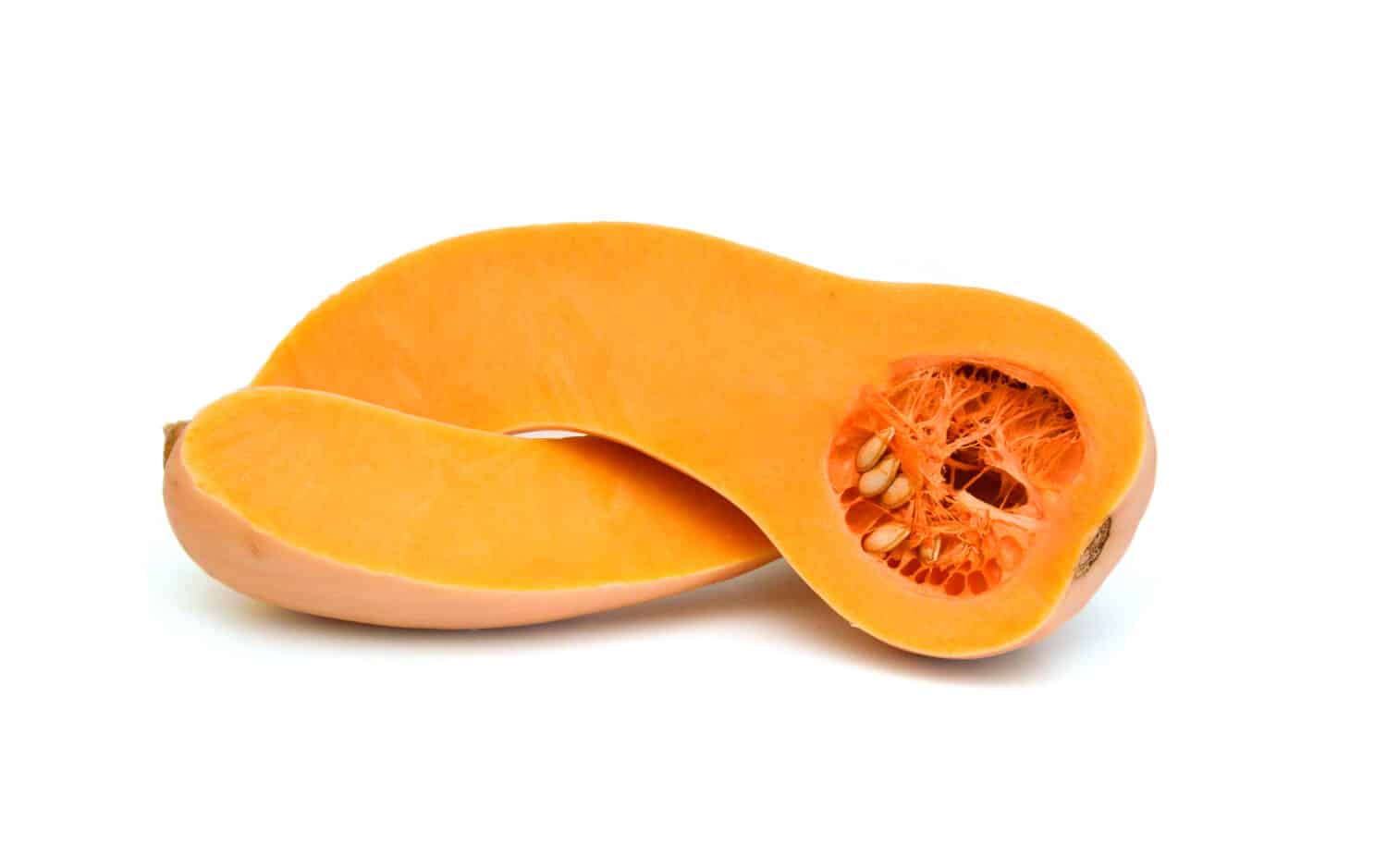
The appearance of butternut squash features a bulbous base with a long tapering neck.
©Toasted Pictures/Shutterstock.com
Nutritional Value per Cup
- Calories: 45
- Carbohydrate: 12 g
- Fat: 0.1 g
- Fiber: 2 g
- Sugar 2.2 g
- Protein: 1 g
- Potassium: 352 mg
8. Burdock Root
Burdock root, also called gobo in Japanese cuisine, is a root vegetable native to Asia and Europe. Despite widespread popularity across various cultures, burdock remains less familiar than other roots like potatoes or carrots.
Part of the Arctium lappa species, burdock belongs to the aster family (Asteraceae) alongside artichokes, cardoons, and endives. Interestingly, both fresh and dried burdock roots yield practical applications beyond food consumption, including medicinal properties, natural remedies, traditional medicine practices, handcrafting, and habitat creation for insectivorous birds during the breeding season.
Description and Appearance
If encountering wild burdock plants, one should avoid plucking them accidentally since their spiny flower heads resemble those found on cockleburs, whose seeds were immortalized via the Velcro brand name after sticking stubbornly onto people’s furry pants. Fortunately, harvesting burdock root means digging up the ground rather than climbing dense shrubs!
These taproot systems can grow over two feet long, although cultivated varieties generally produce shorter ones about a foot long.
When raw, peel off layers of dark brown skin before cooking to remove bitterness and any potential contaminants or soil. After cutting horizontally, you will notice an uneven cylindrical shape with a soft white color. Pay attention to the unique root structure: burdock has a tapering tip and no crown, unlike carrots or parsnips, making identification easy once you become familiar with the distinctive traits.
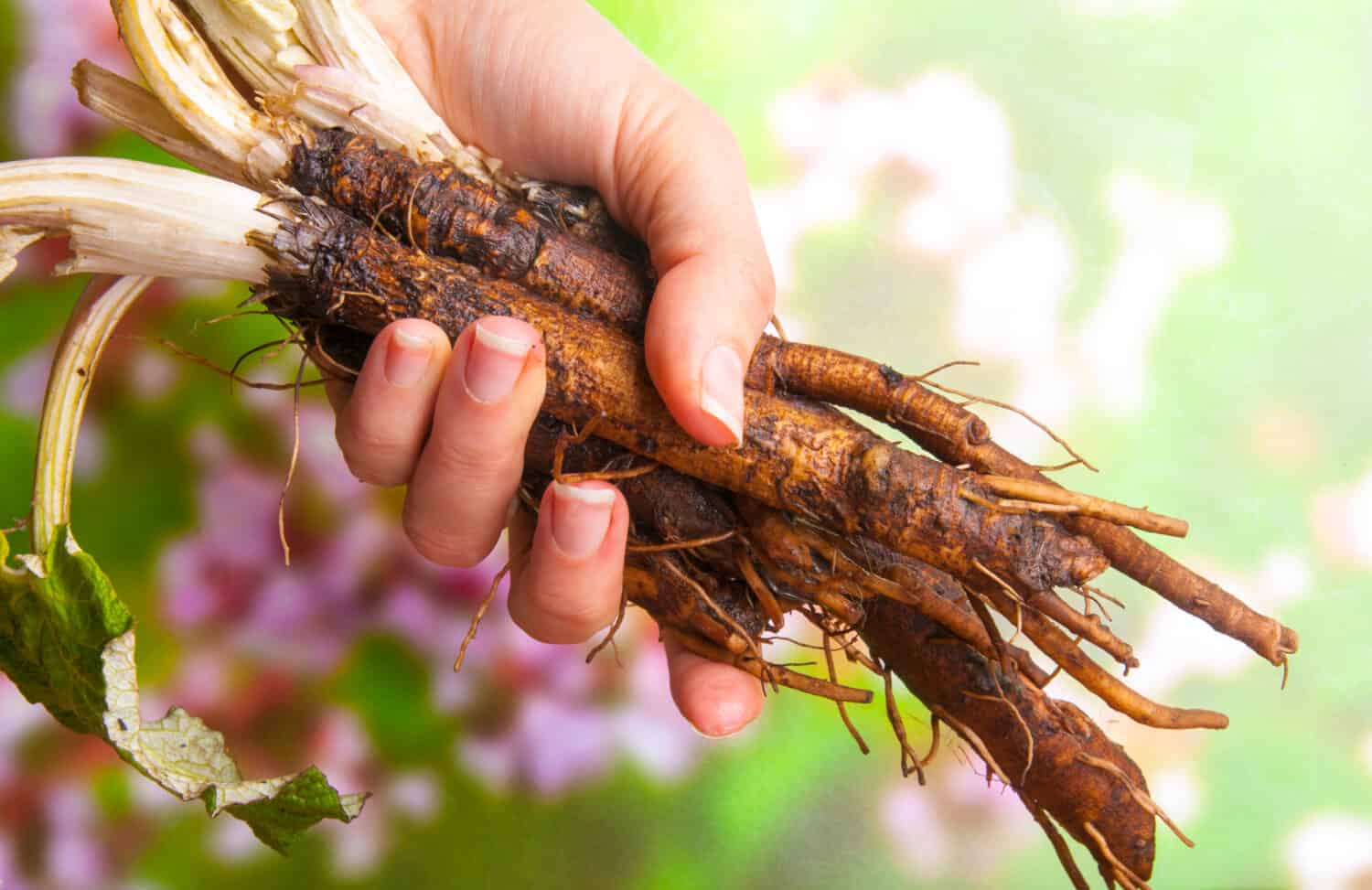
Burdock root, also called gobo in Japanese cuisine, is a root vegetable native to Asia and Europe.
©nanka/Shutterstock.com
Nutritional Value per Cup
- Protein: 2.4 g
- Sugar: 4.5 g
- Calcium: 64 mg
- Fiber: 5.2
- Iron: 1.2 mg
- Magnesium: 59.3 mg
- Phosphorus: 80 mg
- Potassium: 480 mg
- Vitamin C: 4.6 mg
9. Black-Eyed Peas
Despite their popularity in Southern US cuisine, particularly during New Year festivities, black-eyed peas trace their roots back to West Africa. Their journey took them across the Atlantic Ocean via slave trade routes, finding homes in different regions of Brazil and the Caribbean before finally arriving in North America.
Description and Appearance
Black-eyed peas sport cream-colored seeds adorned with a striking black spot. Originating in Africa, they have spread their roots to warm regions across the globe, earning them the aliases of black-eye beans, goat peas, and southern peas.

Black-eyed peas sport cream-colored seeds adorned with a striking black spot.
©Chatham172/Shutterstock.com
Nutritional Value (1 Cup 170 g)
- Calories: 194
- Protein: 13 g
- Fat: 0.9 g
- Carbs: 35 g
- Fiber: 11 g
Final Takeaway: Exploring the B-List
We examined several vegetables and herbs that begin with the letter B. Among them, broccoli catches attention due to its tree-like appearance and versatility. It contains vital nutrients like vitamin C and folate. Beetroot, recognized for its vibrant red or purple hue, delivers a sweet and earthy flavor. It is an excellent source of fiber and potassium. Brussels sprouts resemble miniature cabbage heads. Butternut squash and burdock root offer distinct flavors and nutritional advantages to various culinary traditions. Basil and borage are aromatic herbs that infuse dishes with flavor and possess medicinal properties.
The photo featured at the top of this post is © iStock.com/Quanthem
Thank you for reading! Have some feedback for us? Contact the AZ Animals editorial team.







